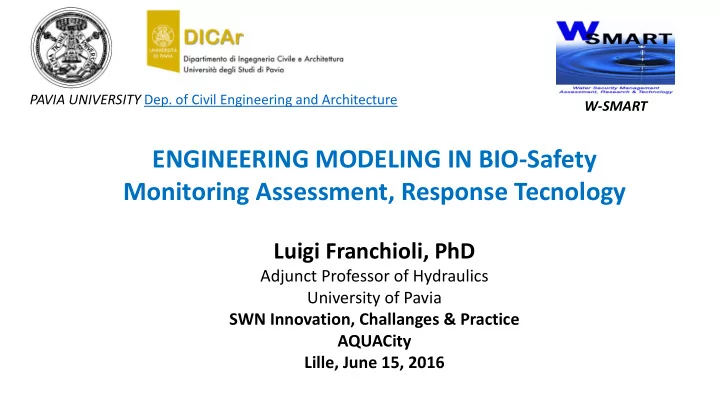

PAVIA UNIVERSITY Dep. of Civil Engineering and Architecture W-SMART ENGINEERING MODELING IN BIO-Safety Monitoring Assessment, Response Tecnology Luigi Franchioli, PhD Adjunct Professor of Hydraulics University of Pavia SWN Innovation, Challanges & Practice AQUACity Lille, June 15, 2016
COMPLIANCE WITH THE REQUIREMENTS OF WATER QUALITY WATER SUPPLY CHAIN CONTAMINATION FEEDING/TRANS TREATMENT DISTR NETWORK - Accidental - Deliberate • pH WATER QUALITY • Turbidity MONITORING IS • Pressure Measured Parameters: • Conductivity RELEVANT • Total Organic Carbon (TOC)
BIO-SMART System Architecture LACKING DATA (OUTCOME OF PHASE «ZERO»» Phase 1 - Eng. Modeling for acquiring database Phase 2 - AI based on Data Analysis for forecasting Phase 3 - MV analysis reactions for detection Phase 4 - Integration and Decision Support
Phase 1: Engineering models to obtain quasi-data OBJECTIVES • Minimize sensor expected detection time Numerical • Minimize contaminated volume before the alarm • Minimize number of sensors Experiments • Maximize number of events detection EPANET-MSX EPANET (Multi Spicies Non-conservative assumpt. Hydraulic Testing Multi-species (interactions btw wall pipes analysis and substances) Quality Analysis Chemical models • Adsorption As +3 Contaminants • E.Coli transportation with conservative assumptions
• 65 nodes Real Network proposed by Alperovits and CASE STUDY • 82 pipes Shamir (1977), constituted by: • 3 tanks HOURLY TIME PATTERN FOR THE NODAL DEMAND (24 coefficients that scale the flow- rate pick value)
EPANET RESULTS – Non specific injections (1) EPANET DOESN’T CONSIDER THE CHEMICAL OR BIOLOGICAL SPECIES TYPE Mass Booster: 0,5 kg/min Injection Duration: 10, 20, 60 min Starting time: 7:00 • If the duration increases, the peak increases until the saturation status • The phenomena ends in approximately one hour • Available detected value in less then 10 min
EPANET RESULTS – Non specific injections (2) EPANET DOESN’T CONSIDER THE CHEMICAL OR BIOLOGICAL SPECIES TYPE Mass Booster : 0,5 kg/min Injection Duration: 20 min Starting time: variable • Plateau absence due to insufficient injection duration • The phenomena ends in approximately 20 min • Available detected value in less then 10 min
EXAMPLE OF EPANET-MSX INPUT: Adsorption As +3 The sw needs some coefficients regarding the chemical reactions involving species, units and time options, the ineraction among species and pipes, the interaction among species and tanks, starting quality conditions
EPANET-MSX INPUT: E.Coli
EPANET-MSX RESULTS (Arsenic, multi-node injection) Mass Booster: 10 μg /L ARSENIC, NODE 8, INJ. AT 36-45-50 Injection Duration: 10 min Starting time: 7:00 ARSENIC, NODE 19, INJ. AT 36-45-50 • Small interaction of monochloramine with arsenic (concentration is more or less constant) • The phenomena ends in approximately 60 min ARSENIC, NODE 45, INJ. AT 36-45- 50
EPANET-MSX RESULTS (Arsenic, single-node injection) Mass Booster: 10 μg /L ARSENIC, NODE 8, INJ. AT 50 Injection Duration: 10 min Starting time: 7:00 ARSENIC, NODE 19, INJ. AT 36-45-50 ARSENIC, NODE 19, INJ. AT 50 • Small interaction of monochloramine with arsenic (concentration is more or less constant) • The phenomena ends in approximately 60 min ARSENIC, NODE 45, INJ. AT 36-45- ARSENIC, NODE 45, INJ. AT 50 ARSENIC, NODE 8, INJ. AT 36-45-50 50
EPANET-MSX RESULTS (E. Coli, multi-node injection) Mass Booster : 1 CFU/L Injection Duration : 7 hours E. COLI, NODE 8, INJ. AT 36-45-50 Starting time : 4:00 • If E. Coli quantity increases, the E. COLI, NODE 19, INJ. AT 36-45-50 level of free chlorine decreases • Immediate effect on the network • Possibility of bacteria detection by analyzing the level of free chlorine
EPANET-MSX RESULTS (E. Coli, single-node injection) Mass Booster : 1 CFU/L Injection Duration : 7 hours E. COLI, NODE 8, INJ. AT 36-45-50 Starting time : 4:00 • If E. Coli quantity increases, the E. COLI, NODE 19, INJ. AT 36-45-50 level of free chlorine decreases • Immediate effect on the network • Possibility of bacteria detection by analyzing the level of free chlorine
CONCLUSIONS • Engineering models (Epanet, Epanet MSX) are appropriate to describe the most common chemical/physical/biological pollutants; • In the shown cases the injection duration doesn’t influence the pick concentration value of the pollutants (saturation at given conditions) • E. Coli injection causes a drop of chlorine (bactericide effect). FREE CHLORINE MONITORING ALLOWS THE E. COLI DETECTION ; • No interaction between arsenic and monochloramine; • The nodal demand influence the diffusion of pollutants (flow-rate circulation change inside the network)
Recommend
More recommend